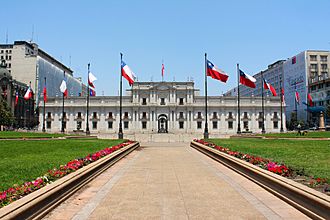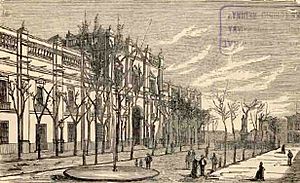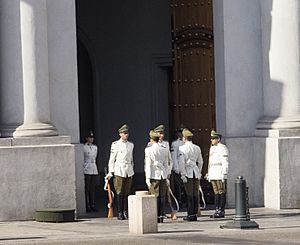Palacio de La Moneda (Chile) facts for kids
Quick facts for kids La Moneda PalacePalacio de La Moneda |
|
|---|---|

View of La Moneda from the Plaza de la Constitución
|
|
| General information | |
| Architectural style | Neoclassical |
| Town or city | Santiago |
| Country | Chile |
| Construction started | 1784 |
| Completed | 1805 |
| Client | Government of Chile |
| Design and construction | |
| Architect | Joaquín Toesca |
The Palacio de La Moneda (which means Palace of the Mint), often just called La Moneda, is a very important building in Chile. It is where the President of Chile works. It also holds the offices for some important government ministers. These include the Minister of Interior, the General Secretariat of the Presidency, and the General Secretariat of the Government.
La Moneda is in downtown Santiago. It takes up a whole city block in the Civic District. It is surrounded by Moneda street to the north, Morandé street to the east, Alameda del Libertador Bernardo O'Higgins to the south, and Teatinos street to the west.
Contents
History of La Moneda Palace
La Moneda was first built as a place to make coins. This is why it is called the "Mint Palace." An Italian architect named Joaquín Toesca designed it. Building started in 1784. The palace opened in 1805, even though it was still being built. Coins were made at La Moneda from 1814 until 1929.
In 1845, during President Manuel Bulnes's time, the palace became the main government building. It was also where the president lived. In 1930, a public square was built in front of the palace. It is called Plaza de la Constitución (Constitution Square). After President Gabriel González Videla, the palace was no longer used as the president's home.
During a military event on September 11, 1973, the palace was attacked. The Chilean Air Force fired rockets and cannons at the building. The damage was repaired and the palace was restored by March 1981. You can still see some bullet marks today. During the repairs, an underground office area was built. This "bunker" was meant to be a safe escape route.
When Eduardo Frei Ruiz-Tagle was president, the palace was painted white. Later, President Ricardo Lagos opened the palace's inner courtyards to the public during certain hours. President Lagos also reopened the Morandé 80 gate. This gate was used by Chilean presidents to enter the palace without going through the main entrance. It was removed during earlier restorations. However, it was put back because it was very important to the people. It was also the gate through which President Allende's body was taken after the 1973 events.
A special ceremony called the Changing of the Guard happens every two days. It takes place at 10 a.m. on weekdays and 11 a.m. on weekends. This formal ceremony started in the 1850s. It lasts about 30 minutes. It includes a band playing music and soldiers with horses marching into the square. The Carabineros de Chile provides the guard unit and the band for this ceremony.
Architecture of La Moneda
Building the Palace
Joaquín Toesca was a famous architect. He worked on many public buildings in Chile, like the Santiago Metropolitan Cathedral. Then, he was asked to design the new royal mint, which became La Moneda Palace.
Work on the building began in 1784. Materials came from all over Chile and other countries. Limestone came from Polpaico. Sand came from the Maipo River. Red stones came from a quarry at Cerro San Cristóbal in Santiago. White stone came from Cerro Blanco. Oak and cypress wood came from Valdivia. Metal parts from Spain were brought from Vizcaya. Twenty different types of bricks were made in Santiago. These bricks were used for walls, floors, and other parts of the building. The walls were very thick, more than a meter (about 3 feet) wide.
Toesca died in 1799, before the building was finished. A military engineer named Agustin Cavallero took over the project. The "Mint House of Santiago de Chile" finally opened in 1805.
In 1929, an extra part was added to the palace. President Carlos Ibáñez del Campo asked for this annex. It was built to give the palace a front facing Alameda Avenue, Santiago's main street. Josué Smith designed this part. He carefully followed Toesca's original design. This three-floor annex used part of the old mint building. The mint then moved to a new location.
In 1940, an old mint building, part of Toesca's first design, was taken down. This made space for the Patio de los Naranjos (Orange Tree Courtyard).
Palace Style and Design
The Palacio de la Moneda is built in a neoclassical style. This means it uses ideas from ancient Greek and Roman buildings. It has influences from Roman Doric architecture. The building's wide, flat shape and rectangular design show strength and stability. This is noted on the UNESCO website. Its main front faces Moneda street. The rooms are arranged around central paths, creating several patios (courtyards).
Behind the main front, there are three courtyards. The Patio de los Cañones (Cannon Courtyard) is like an entrance hall. There is also a covered courtyard. Finally, there is the Patio de los Naranjos (Orange Tree Courtyard). This is where presidential ceremonies often happen.
Some experts say La Moneda is the only building in Latin America that is purely in the Italian neoclassical style.
The building has been changed many times by different presidents over the years. The biggest restoration happened after the 1973 military events. Large parts of the building were damaged or destroyed then.
Plaza de la Ciudadanía
To celebrate 200 years of Chile's independence in 2010, a new public square was built. It is called the Plaza de la Ciudadanía (Citizenry Square). It is on the south side of the palace and stretches down to the Avenida Libertador General Bernardo O'Higgins. Building started in May 2004, and the square opened in December 2005.
Undurraga Devés Arquitectos designed the Plaza de la Ciudadanía. It has been called one of the most important public works in Chile in the last century. Paths from the square lead to the underground Palacio de La Moneda Cultural Center. This center has many exhibitions about Chilean culture and history.
Gallery
-
Statue of the President Arturo Alessandri at Citizenry Square
See also
 In Spanish: Palacio de La Moneda para niños
In Spanish: Palacio de La Moneda para niños
- La Moneda Palace Guard
- Palace of Cerro Castillo










